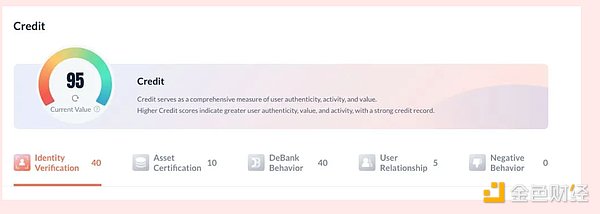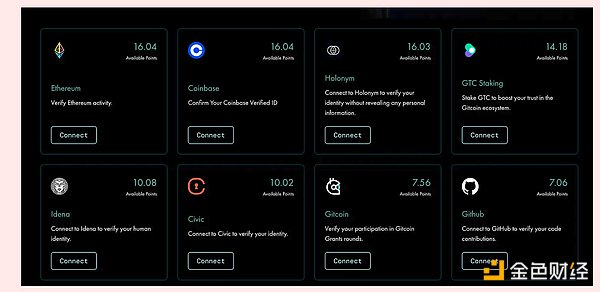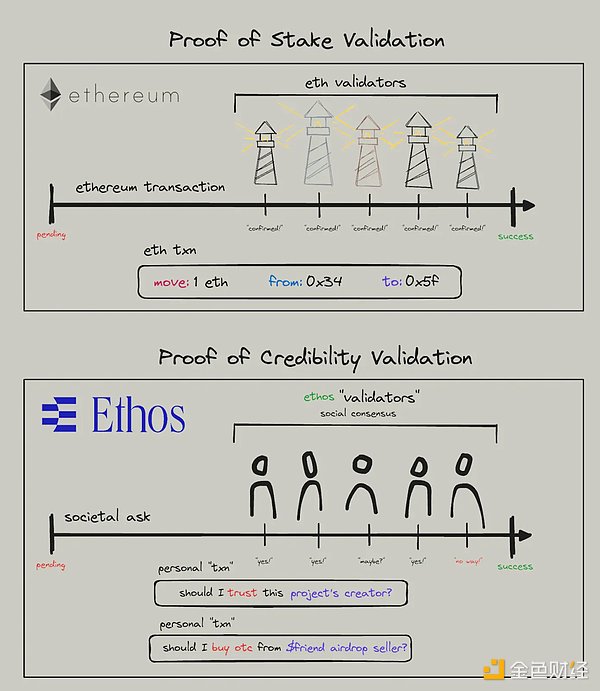Author: Francesco Source: substack, @fraxcesco Translation: Shan Ouba, Golden Finance
For many years, there has been constant discussion about on-chain reputation. Since 2017, various projects have tried to solve this problem and give on-chain users the ability to use the reputation layer to understand who they are trading with.
Today, with various scams, SocialFi and celebrities constantly issuing worthless tokens, this is more important than ever.
This article introduces the concept of on-chain reputation and its importance, focusing on projects such as Debank and Ethos Network that are committed to it.
On-chain reputation
On-chain reputation answers a simple question:
How do we evaluate the trustworthiness of the people we interact with in a decentralized system?
In centralized systems, a third party typically ensures this reputation (e.g., credit score, Interpol Red Notice, bank account).
Is there a way to replicate reputation guarantees in a distributed system?
These efforts go beyond a single protocol and attempt to innovate in this space. To be useful, this reputation system must go beyond a single protocol and create a unique set of standards that can be recognized on Web2 and Web3 platforms, thereby establishing a common framework across chains.
Any attempt that does not become a new standard will render this process useless.
According to a16z, “to make decentralized identity mainstream, we must first build systems that map people’s relevant off-chain experiences and relationships on-chain” and then “we must build mechanisms to standardize, process, and prioritize the data streams that will be added to the chain” and “address the inherent challenges of decentralized identity, including the lack of context of on-chain records and the problem of access to the decentralized network”.
Currently, even the inputs of blockchain explorer records are very basic. Without the additional context of the transaction, it will be more difficult to map and assign reputation scores.
For example, receiving an NFT as part of an exchange should have a different weight than receiving an NFT for extraordinary community contributions to a project.
In addition, in the crypto space, reputation comes in many forms, such as protocol trust, lending credit scores, and the records of project founders.
Only with all these factors in mind will this system be applicable to a variety of use cases, incorporating on-chain reputation into "offline activities based on the public query nature of decentralized identity."
Three steps:
Record data on-chain
Map and interpret data
Convert to a "reputation score"
True standardized reputation
In its "Builder Request", the Base team outlined their vision for the success of on-chain reputation. They likened "on-chain" to the next "online", arguing that reputation plays an important role in every on-chain account.
In this context, “reputation protocols” could create more trust on-chain. They speculate that this could be similar to FICO (the most well-known name for credit scores) or Google Page Rank scores.
Wallets could use these standards as a fraud prevention mechanism, implementing warnings for risky addresses. We’ve already seen Rabby take the lead in introducing warnings for new contracts or scam tokens.
Others who have introduced some reputation measures include blockchain analytics companies such as Chainalysis based on on-chain behavior, and DeBank through the creation of the DeBank Credit score.
The credit score is a “comprehensive measure of user authenticity, activity, and value.” Higher scores mean more activity and user authenticity, but in its current state, DeBank Credit cannot yet be used as a proxy for reputation.

In addition, we can also observe the emphasis on formal identity verification, which is still a controversial topic in the crypto space.
A successful example of a reputation mechanism is Gitcoin Passport.
Gitcoin Passport calls itself an "authentication aggregation application."
Just like a regular passport, users can collect stamps by verifying previous activities or performing tasks and verifying through different Web2 and Web3 validators:
These stamps increase the default Humanity Score, a proxy for trustworthiness of Web3 projects assigned to each user. A higher Humanity Score means more opportunities to be granted, with a minimum score of 20 to be considered human.
Here are examples of stamps that can be collected:

One advantage of Passport is that it protects user privacy, using a zero-knowledge approach to create a verifiable credential that proves that a user has performed a specific activity, but does not collect any personally identifiable information.
Another interesting attempt is the "verifiable proof of verification" being undertaken by the Ethos Network.
Ethos is developing a "reputation platform" that is integrated into the broader ecosystem, not limited to a single dApp.

This platform can be integrated into existing interfaces (Chrome plugins, Metamask extensions) and dApps.
The blueprint of this new type of social consensus is similar to Proof of Stake, where users act as "social validators."
Users can “bet” on others to show trust in them
Bad actors can be punished
Social consensus providers can be rewarded
Ethos introduces economic rewards and penalties to ensure that:
At the same time, a balance must be found to ensure that reputation cannot simply be bought.
On Ethos Network, users will be able to:
Rating: Developing Reputation Beyond Providing Economic Stakes
Staking: Similar to staking, users can stake their ETH on others and earn ETH yield. Those who are bonded will receive 10% of the yield to incentivize validators and referrals.
Punishment: If a validator misbehaves, users who have bonded their ETH can propose penalties that remove up to 10% of the offender’s staked ETH from the Ethos contract. Those who propose penalties that are rejected will be penalized.
Certification: Reflects authority, reputation, and influence from other sources
All of these mechanisms will be transformed into a single reputation score.
While these mechanisms focus less on on-chain reputation, other notable examples in the space include:
Worldcoin: This VC-run giant promises to scan your iris and airdrop some WLD tokens for you. Whether its purpose is noble or utopian is up for debate. However, through biometric scanning of the user’s iris, they bring proof of humanity. This opens up new avenues for risk, but is also an exciting experiment.
ENS: Translates crypto addresses into human-readable names, facilitating “on-chain messaging”.
A Long Road
Developing a truly standardized and universal on-chain reputation system will be a long and difficult road, with many challenges.
Centralized Solutions
The main challenge is to ensure that all of these systems are truly decentralized and not controlled by a centralized party like Worldcoin or even Gitcoin Passport.
How can on-chain reputation be achieved in a decentralized manner? Any system that does not meet this will lose its trustless element.
Crypto Reputation Can Be Manipulated/Buy
Privacy Must Be Preserved
Must Go Beyond Single Wallet Binding and Have Universal Applicability
This implementation will be the result of the joint efforts of all participants, wallets, blockchain browsers, dApps and networks.
Vision with real-world use cases
What is the ultimate vision of on-chain reputation? Here are some real-world examples and scenarios where on-chain identity can be helpful.
Public Resumes: Anyone can assess the reputation of other participants by assigning a single reputation score to each user. In addition, every article written, contribution or community participation is recorded and can be used as a proof of reputation.
Celebrity Tokens: With celebrity tokens becoming a new trend, data on these issuances can be used to determine the trust profile of each celebrity. We have seen a series of scams by many celebrities. This problem can be partially solved through a quick risk assessment to show users the risks of these tokens.
Meme Developers: Meme developers are at their peak. However, many abuse this power to conduct “pump and dumps” or even outright scams. We have seen some personalities who have been serial meme developers, repeatedly committing scams. Identifying whether a token’s deployer is a previous scammer can be very useful for risk assessment for users.
KOL Selling: Crypto Twitter is characterized by influencers (KOLs) promoting these tokens while selling their holdings. Imagine if you could have a reputation ranking to determine whether your favorite KOL is trustworthy, or know who are outright dumpers and scammers.
Loyalty Programs: Developing an on-chain reputation system will allow dApps to have deeper information about user interactions, creating customized programs that focus on rewarding high-quality interactions that have high value to the protocol.
Other existing reputation tools
In addition to the previously mentioned, there are various tools contributing to trust and accountability.
Reputation Building and Tracking
Collab.Land: An NFT-based bot that verifies ownership and DAO contributions.
Karma: Provides visibility into DAO contributions.
PNTHN: Tracks DAO member reputation.
SOURC3: On-chain reputation management on the platform.
Reputation and Authentication
Pentacle: Helps users navigate the protocol.
ONT ID: Identity framework for decentralized identifiers and verifiable credentials.
Krebit: Users can prove their identity without revealing it, protecting privacy.
Orange Protocol: Multi-chain reputation system as verifiable credentials.
OutDID: Zero-knowledge proofs for private identity authentication.
Reputation and Governance
Metopia: A reputation system for governance.
Astraly: An on-chain reputation and reputation-based token distribution platform.
Spect: A code-free tool that helps DAO contributors create child DAOs.
SourceCred: Helps incentivize contributors and reward high-quality participation.
 Beincrypto
Beincrypto
 Beincrypto
Beincrypto Beincrypto
Beincrypto Beincrypto
Beincrypto Coindesk
Coindesk Nell
Nell Beincrypto
Beincrypto Bitcoinist
Bitcoinist Cointelegraph
Cointelegraph Ftftx
Ftftx Cointelegraph
Cointelegraph